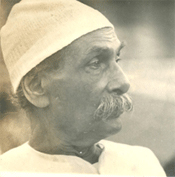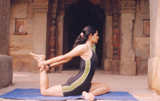Insight
Body-Energy
Abstract
Nolini Kanta Gupta was the foremost among Sri Aurobindo’s disciples who had been with him right from the revolutionary days of the Indian Freedom Movement. A man of few words, he was a brilliant and erudite scholar, a mystic poet and a yogi with seer vision. In this article, he shares some of his yogic insights regarding the human body as seen from a consciousness and spiritual perspective. One can clearly feel in his writings a depth and wideness not normally found in our surface look on things.
The Mother spoke once of the body being like a fortress, a strong shelter protecting you against enemy-attacks, the forces that are around roaming in the open spaces, the forces of physical and even moral disruption. The ancients used to refer to the body as a walled city the gates of which are to be carefully guarded. It is also compared to a temple, a firm structure wherein God is to dwell, which is to be kept always clean, trim and tidy. The body itself was worshipped as a holy thing almost as a Divinity by certain schools of spiritual discipline.
These are, so to say various dimensions of the body; one more, somewhat of a different category, may be added. The body is a battery, an accumulation of energy, of energy and consciousness, of energy-consciousness. We are all familiar with the modern concept of the material particle being concentrated energy: it is tremendously concentrated and that is why it looks as though dead solidity. In reality its stilled high potency harbours almost an immeasurable force of creation and destruction.
The release of energy, material energy, in matter, is the business of Science and the scientist; the release of consciousness, the energy of consciousness in matter is the business of yoga and the yogi. The tantrik discipline was in a large way occupied with this mystery. It found and developed its own method and process and its success in its own field is also well recognised.
The body-content thus is essentially consciousness consolidated, crystallised. The problem then is how to release it. The first thing is that you must be conscious, you, that is to say, your body must be conscious, must be aware always of what it is doing: living, moving, acting; the body must be doing all that consciously, almost voluntarily: there shall be no involuntary movements. Each physical gesture must know itself by feeling itself in the act. It is not that the mind should know, the mind can have only a memory, but that the limb itself has to pursue its function knowingly, in full awareness. At the beginning there is inevitably a mixture of mental knowing but that is to be cleaned out and overpassed. One is conscious, can be conscious only through consciousness; consciousness is born through consciousness. It manifests, it grows through incubation, through self-centration. Energy energises itself, as the Upanishad says, tapas taptvā. Energy is consciousness in movement and in moving it expresses itself, embodies itself. A muscle, for example, when moving, awakes to its own activity, the awakening is not confined to itself, but it extends gradually, extends to all its constituent cells and even to contiguous cells. The process in this way permeates the whole body and the entire material content of the body is filled with consciousness and with its radiant energy.
There is however a basic preliminary necessity, a preparatory condition: the first essential condition under which the body can be conscious of itself is its freedom, its absolute freedom. The body must be liberated wholly and entirely, it must feel its perfect freedom. As at present it is a slave: it never knows its own will, it is always under the orders of either the vital or the mind or both. Under the control of this dual masters — a cruel diarchy — the body has lost all its independent movements. The activities, almost all, of the present body are not really its own, they are expressions of an imposed will. In order to have and to be aware of its own will the body must be freed from its alien imposition and as soon as it gains its freedom, it will know itself, learn itself, learn its own movements. It will gradually shred off all the wrong and distorted movements which form its present habits. We shall find that in itself the body is a sane entity and it is not in need of many things that have been suggested to it and instilled into it by forces that are outside it, almost foreign to it, the mental and the vital forces. The liberation will bring to it automatically the awareness of its own self, it will become, that is to say, conscious of itself and this consciousness will bring with it a pure and fresh energy which is that of its true self. As in the case of a subject nation the very fact of liberation brings to it the energy of self-consciousness and an exhilarating delight in the expression of the newfound selfhood, even as also in the case of the individual human being when he is freed from serfdom and slavery and bondages, he attains, realises the dignity of self-consciousness and self-power, even so the material body too becomes illumined with its freedom and rejoices in its power and energy to express its own truth. The first effect of freedom after a long subjugation is likely to be a spell of erraticism, but that is sure to die away if there is a corrective central will.
The body-movements in the animal are more authentic and truthful for they are not subsidised and suborned by the vital and mental injunctions, and they are more ordered and controlled, not subject to idiosyncrasies that sway the human character. They are more free and more natural: the same essential freedom and authenticity and purity shall belong to the body natural of the highest mode of being and consciousness. However, in this age, at the present time the human body is inevitably moving towards such a consummation – towards freedom and buoyancy and radiancy, a new valency, a new self-law. The individual efforts are more than supplemented by a Grace that is at work in a supreme effective manner: for this is the hour of God – “when even a little effort produces great results and changes destiny.”
Nolini Kanta Gupta. Collected Works, Volume 4. Pondicherry: Sri Aurobindo International Centre of Education; 1970, pp. 333-5.
Share with us (Comments,contributions,opinions)
When reproducing this feature, please credit NAMAH,and give the byline. Please send us cuttings.



